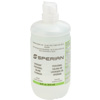Emergency Eyewash Stations & Requirements

According to the Center for Disease Control and Prevention, each day about 2,000 U.S. workers have a job-related eye injury that requires medical treatment. Chemical burns to one or both eyes are common.
For many workers, these injuries can result in blindness. Proper safety equipment, such as face protection and eyewash stations, can save a worker's eyesight.
OSHA and ANSI Requirements
The Occupational Safety and Health Administration (OSHA) standard 29 CFR 1910.151 requires employers provide the ability to quick drench or flush the eyes and body when an employee may be exposed to corrosive materials.
American National Standards Institute (ANSI) Standard Z358.1-2009 sets universal minimum performance and use requirements for all eyewash stations and drench shower equipment.
ANSI standard Z358.1-2009 says an eyewash station must:
- Be accessible within a 10-second walk from the hazard
- Be accessible without the need to walk up or down stairs, ladders, etc.
- Deliver a 15-minute continuous flow of tepid fluid at 0.4 gallons per minute and be 60-100°F
- Be located in areas where caustic or hazardous substances are present
- Activate in one second or less and with one single motion
- Be unobstructed
- Be highly visible and identified with a sign
Environments That Require an Eyewash Station
According to ANSI standards, the following areas must meet emergency eyewash compliance guidelines:
- Painting and solvent operations
- Battery charging stations
- Tool parts washers
- Laboratories
- Hazardous chemical storage
- Chemical pumping and/or mixing areas
- Anywhere you use a chemical that has MSDS eyewash requirements
Choosing Between Plumbed and Portable Eyewash Stations
Plumbed eyewash units are permanently connected to a source of tap water and deliver a constant, steady stream. In some circumstances, OSHA requires a safety-drenching shower as well as an eyewash station.
ANSI requires plumbed or fixed eyewash stations be activated once a week to verify proper operation and to flush away bacteria buildup that results from stagnant water.
Portable eyewash stations may provide water, saline solution, or 100% sterile saline.
- They are easy to place and relocate
- The temperature can be maintained inside the unit
- Saline more closely matches the pH of the eye
Types of Portable Eyewash Stations
Mixed concentrate stations store a mixed solution of tap water and preservative in a tank. The solution can last up to six months. Maintenance includes cleaning and refilling the tanks twice a year.
Cartridge-based stations use factory-sealed fluid cartridges. The shelf life of these cartridges varies with some lasting up to two years. These stations are relatively maintenance free except for replacing a used cartridge, which is quick and easy.
Supplemental Eyewash Equipment
Supplemental eyewash equipment includes bottled eyewash, or single head drench hoses. Supplemental equipment does not meet requirements for a unit that delivers the mandatory 15-minute flush. These supplemental units are meant to provide immediate flushing in the event of an accident.
According to ANSI standard Z358.1-2009, "A personal wash unit may be kept in the immediate vicinity of employees working in a potentially hazardous area. The main purpose of these units is to supply immediate flushing. With this accomplished, the injured individual should then proceed to a plumbed or self contained eyewash and flush the eyes for the required 15-minute period."
Where to Locate Eyewash Stations
Location and ease of access to the eyewash station is vital. An injured person may not be able to see while finding the eyewash station. The eyewash station must be as close as possible to where chemicals are being used.
According to ANSI, eyewash stations must be:
- Located within a 10-second walk from the hazard
- On the same level as the hazard
- Immediately adjacent to the hazard
- Well-lit and identified with a sign
Eyewash Station Tips
- Keep eyewash stations in an open area, not behind a closed or locked door
- Assure flushing fluids remain tepid, about 60-100°F, per ANSI requirements
- Install the unit at a proper angle and height to ensure a steady stream of 0.4 GPM
- Keep the eyewash station free of clutter, at least six inches from a wall or the nearest obstruction, per ANSI requirements
- Regularly test stations to flush harmful bacteria
Shop Emergency Eyewash Stations & Showers
NOTE: This information is a summary interpretation and was prepared as general reference material only. This summary is not authoritative as laws can be amended over time. For specific compliance requirements and updates, please refer to the actual code language and the statute or legal counsel.





